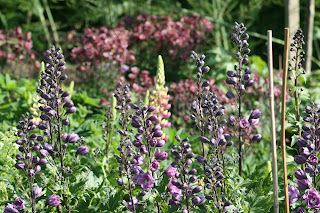My little friend. He turns up whatever the weather, accepts a cuddle then, gets on with the business of catching lunch. I do know it's mostly birds and rats and that I'm attracting them by feeding them daily but, I try to keep the birds out of his reach. Unusually, he is a male. Normally it is the females who are the killers. But, he is cute and I believe, he lives off his hunting. Don't know his name but, he responds to 'Puss'
When I first took on my plot I was anxious to grow enough vegetables and a wide enough range of vegetables to provide for my needs all year round.
In my first year I came pretty close – it was a mild winter and although I became heartily sick of purple sprouting broccoli by the end of spring, I only had to buy onions, garlic and potatoes from January onwards and mushrooms occasionally (I've never attempted to grow them).
Although I'd never attempted to grow them before, I do love leeks and they are an important basic vegetable for use during the late autumn, winter and into spring. That first year I sowed a whole packet of Musselburg(Dobies) – it seemed like a good, reliable, not too expensive variety. I think possibly every seed must have germinated. I had leeks to give away to anyone who wanted them.
One of the other plot holders who had grown leeks successfully for many years recommended that I plant them out before the end of May. In a normal year this is probably excellent advice – this year it has not been quite so easy as the ground is rock hard after the very dry spring. With this practice you can start to eat excellent leeks by the end of October though, to have a crop to take you right through to April it is important to also have a later sowing. Last year I shared my early sowing with my daughter and she shared her later sowing with me. They were all excellent and what an great plan!
We thought this year, we would use the same strategy again. I sowed seeds in my polytunnel on 1st March. I thought I’d try a couple of different varieties so started with F1 Carlton (from Dobies). The germination rate was dismal – I believe I got 15 plants! I sowed again. This time Toledo (Dobies) – the result has been even more disappointing and the ones which did germinate have made little progress. While I might be wrong, I believe the unusually warm, dry weather this spring has been responsible for the poor results, not just in leeks but with other crops as well.
I have sown again, outdoors so I just might have enough leeks though, only 15 to see me through the autumn! I think I might be begging!
The recommendation is for the leeks to be ‘pencil’ size when transplanting. As always some of my pencils are small and skinny and some really quite chunky but, they all grow just the same.
We all know that, when transplanting it is important that the roots should have as little disturbance as possible - well, with leeks, it seems, this is not always the case. The first of my advice of transplanting leeks is as follows:
-Water the ground where you are going to plant your leeks, really well.
- Using a pair of sharp scissors, trim off the ends of the roots and the tops of the leaves.Using a dibber(I use a dibber a neighbour gave to me made from an old spade handle – it is excellent). Whatever you use, you will need something which will form a hole 2-3cm across(1in) and about 15cm deep (6in).
- You should plant the leeks about 15cm(6in) apart in rows about 20-25cm(8-10in) apart – wide enough to be able to hoe comfortably between the rows.

- Drop the prepared leeks into the holes then fill the holes with water.
Well, I have read around quite a bit on the subject of transplanting leeks and lots of different advice is given. Some information will suggest that they should be germinated in individual cells or pots to avoid disturbing the roots. Others suggest digging a trench and placing the young leeks along it.
I started by using the method I’ve given above and it has worked extremely well with no losses after transplanting so, I guess I’ll stick with that method.
It is a bit like the continuing debate on when to water tomatoes. Some experts say they should be watered a little twice a day. (That would seriously not suit me!) Others say they should be given a good drenching every 3-4 days with nothing in between.Apparently it makes the plants lazy and shallow rooted !
I think we must try different methods and see what works best for us. Good luck. But, please do leave a comment if you have any better advice.




































